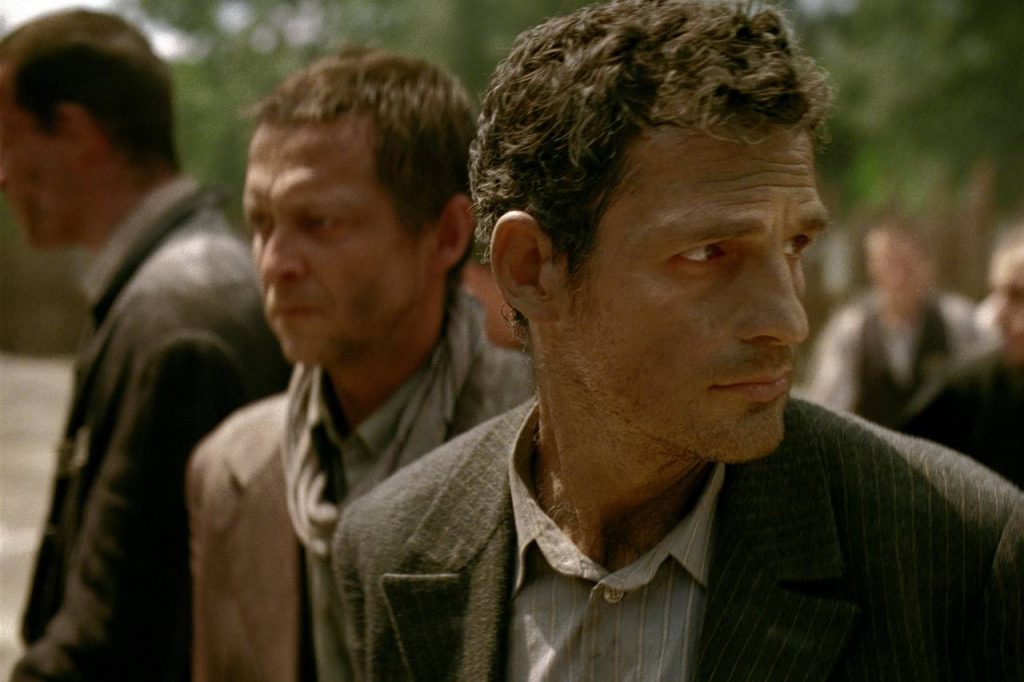Even though it is a true lesson in technique and direction, Son of Saul deserved to have a more interesting protagonist with better motivations
Son of Saul (Saul Fia) (2015)
Directed by László Nemes. Written by László Nemes and Clara Royer. Starring Géza Röhrig, Levente Molnár, Urs Rechn and Sándor Zsótér.
In extermination camps during the Holocaust, the Sonderkommandos (a German word that means “special unit”) were special groups of prisoners (usually Jews) who were forced to help the German Nazis with the disposal of gas chamber victims. Because they knew up close what happened to the inmates who were brought to those chambers (being therefore considered “bearers of secrets,” or Geheimnisträger), they were separated from the rest of the camp and worked no longer than a few months before being gassed (and replaced with new arrivals) so that their knowledge about the mass murder process didn’t reach the outside world.
It is within this horrific context that László Nemes’ Son of Saul follows Sonderkommando Saul Ausländer (Géza Röhrig), a Hungarian prisoner in 1944 Auschwitz who seems befuddled by what takes place around him and decides to find a rabbi to bury the body of a dead boy whom he takes for his son. With this premise in mind, it is not hard to understand why this film became an instant favorite among critics and festivals, and even took home an Oscar for Best Foreign Language Film (for Hungary). It deals with a dark subject matter seen as historically important and has the type of dramatic power that should guarantee awards and praises — although that doesn’t mean the film is special or superior as a character study either.
Holocaust films normally employ techniques that explore the locations without making any concessions about the horrors their characters witness. That includes using a large depth of focus and a widescreen aspect ratio (think of Schindler’s List (1993) and The Pianist (2002), for instance). Son of Saul, however, employs a very narrow aspect ratio of 1.375:1 that squeezes the action and mise-en-scène inside a claustrophobic small frame, and an extremely shallow focus that blurs everything surrounding the character. Nemes also increases the tension even more by keeping us on Saul’s shoulders as he moves around that hideous place (almost like a first-person movie), creating several long takes with a handheld camera.
More interesting, Tamás Zányi’s superb sound design creates a hellish cacophony of whispers and human voices in eight languages that were recorded and attached to the film’s original recording, amplifying what we hear as a counterpoint to the narrowed imagery that we see. It becomes clear that Nemes’ purpose is to create a powerful, immersive experience by forcing us to share Saul’s nightmarish auditory assault and lack of vision (also psychological) in an oppressive atmosphere of terror — made even darker by László Rajk’s production design with its dirty barracks and dark colors, as well as Mátyás Erdély’s drained, yellowish cinematography that uses a 40 mm lens to emphasize the space around the character.
But, whereas Son of Saul is indeed a true lesson in technique and direction, it makes it real hard for us to feel any sympathy or empathy for a man who risks the lives of everyone around him for a dead body — the body of an unknown boy who may or may not be his son. Why he would insist on a lie I cannot tell. So, when another inmate says to him at a certain moment that he is playing with their lives, it is almost impossible not to agree — and I personally felt the strong urge to punch Saul in the face at least twice, which I would probably do if I counted on his help. Besides, the way the film presents some details of the “treatment” procedure (a euphemism for extermination) seems to only serve the purpose of shocking us.
On the other hand, Son of Saul does expose the dehumanization of the Jews in those death camps in a compelling way, showing how they were treated as only numbers (instead of names) and discarded as “pieces” (stücke) after gassed — their valuables, such as gold, salvaged from their belongings. At the same time, it is curious to see how they had some sort of clandestine network, like when a prisoner mentions his “guy at the office.” With the kind of escalating horror that intensifies in its last forty minutes, Son of Saul proves to be ideal Oscar bait. I only wish, though, it had a more interesting protagonist with better motivations.





